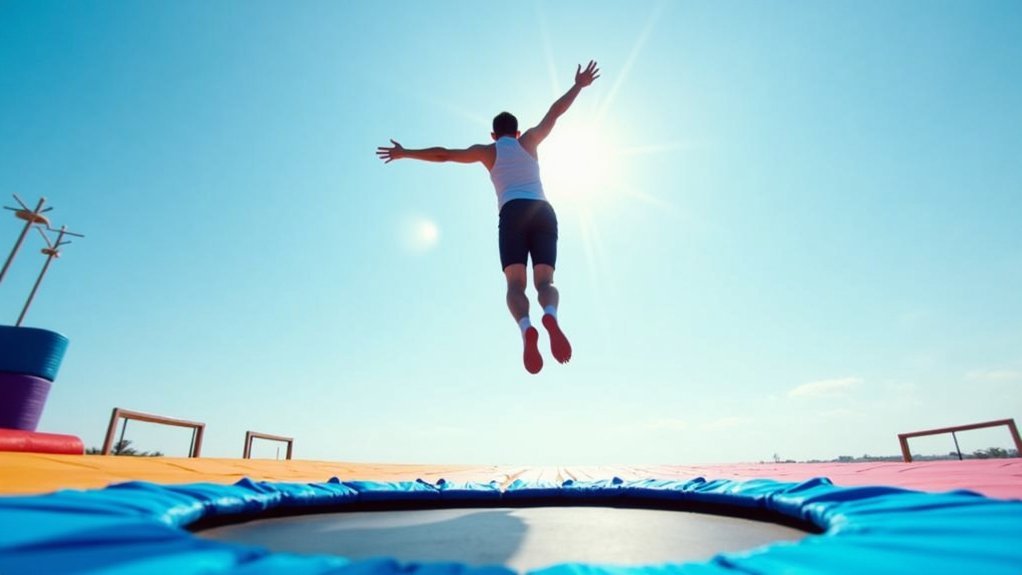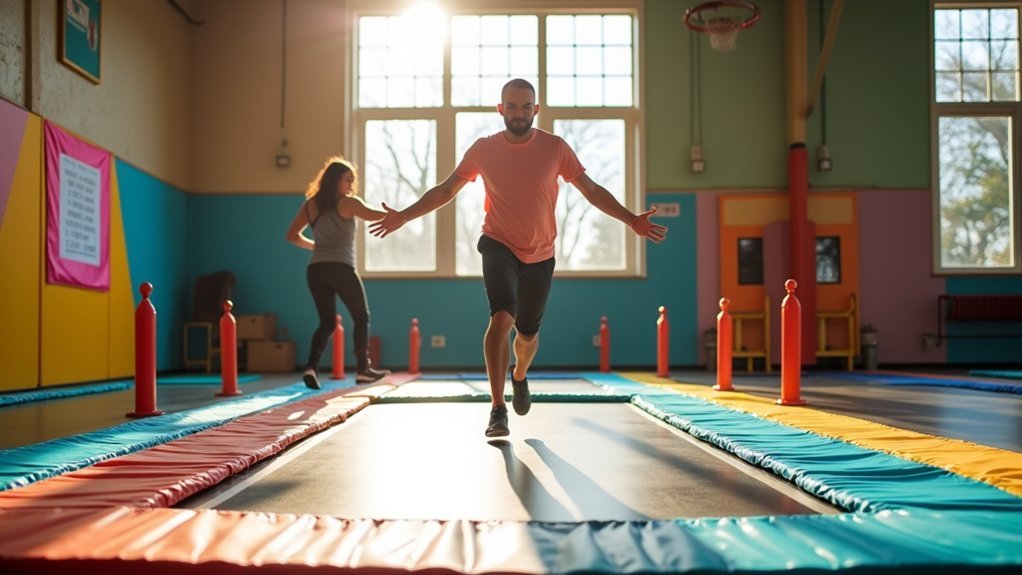Trampoline training fixes balance disorders by disrupting and rebuilding neural pathways through controlled instability. When you bounce, your vestibular system receives consistent stimulation, enhancing spatial awareness and proprioception. The airborne moments create brief sensory challenges that force your brain to adapt, while the landing phase strengthens stabilizer muscles and develops new motor patterns. Studies show remarkable improvements across various balance disorders after just six weeks of regular sessions. Discover how this unique therapy transforms rehabilitation through five key physiological adaptations.
How Trampoline Challenge Disrupts and Rebuilds Neural Pathways

While traditional balance exercises offer limited neurological stimulation, trampoline training creates a unique environment that actively disrupts and rebuilds neural pathways.
When you bounce, you trigger a three-phase process: destabilization, conflict resolution, and reconstruction.
Each jump overrides your habitual postural strategies, forcing your brain to explore new motor patterns. The unpredictable rebounds expose weaknesses in your neural circuitry, amplifying error signals that demand correction.
During airborne moments, you experience brief sensory deprivation that compels reliance on internal movement models. This unique sensory experience significantly enhances spatial awareness critical for maintaining proper balance.
Your brain responds by developing automated spinal reflex arcs and distributed motor engrams from consistent rebound patterns.
Mid-air rotational challenges build redundant cortical representations, ensuring you have fail-safe balance recovery mechanisms.
This process strengthens cerebellar networks responsible for microsecond-level timing adjustments essential for stability.
The Science Behind Rebounding’s Vestibular System Benefits
The neural pathways rebuilt through trampoline training connect directly with your vestibular system—the body’s primary balance center housed within the inner ear.
This sensory network constantly monitors your position and movement, sending essential signals that help maintain equilibrium and spatial awareness.
When you bounce on a trampoline, you’re providing straight-line vestibular stimulation that challenges and strengthens this system.
The repetitive motion creates a unique combination of sensory inputs that your brain must process and adapt to in real-time.
- Enhances sensory integration by simultaneously engaging vestibular and proprioceptive systems
- Creates rhythmic stimulation that regulates your nervous system
- Improves spatial awareness through consistent feedback about body position
- Develops coordination through integrated sensorimotor processing
- Provides low-impact stimulation that’s gentler on joints than traditional exercises
Research shows that the curved leg design of quality rebounders like the JumpSport Fitness Trampoline offers enhanced stability during vestibular training exercises.
Comparing Trampoline Results Across Different Balance Disorders

Research comparing trampoline training across various balance disorders reveals consistently positive outcomes, though effectiveness varies depending on the underlying condition.
Stroke patients show remarkable improvements in both static and dynamic balance, with enhanced center of gravity management and gait stability when using modified trampoline protocols with handles.
You’ll find that neurological balance disorders respond well to the continuous sensory feedback trampolines provide, while age-related balance issues benefit from the combined core stability exercises.
Six-week programs yield significant results across populations, with trampolines proving as effective as resistance training for young adults with mild balance deficits.
The unstable surface promotes critical neuromuscular adaptations regardless of the disorder’s origin, making trampolines a versatile rehabilitation tool that can be tailored to your specific balance challenges.
For female volleyball players with chronic ankle instability, trampoline training has demonstrated significantly greater improvement in posterior-medial orientation and total dynamic balance score compared to other training methods.
Five Key Physiological Adaptations From Regular Bounce Training
Bounce-based training on trampolines triggers five major physiological adaptations that directly improve balance function. Your brain and body undergo remarkable changes when regularly exposed to the controlled instability of trampoline surfaces, creating cascading improvements throughout your neuromuscular system.
- Enhanced proprioception through increased mechanoreceptor activation and sensitivity in joints, improving your spatial awareness of limb positioning.
- Optimized postural control via multidirectional challenges that train precise weight-shifting and ankle strategy dominance.
- Strengthened stabilizer muscles as eccentric load absorption recruits deep core and lower extremity stabilizers simultaneously.
- Neuroplastic adaptations in your motor cortex through novel movement patterns and improved feedforward mechanisms.
- Neurotrophic support from increased cerebral blood flow and BDNF upregulation that enhances synaptic plasticity in balance circuits. Athletes consistently show that these adaptations can persist even under conditions of exercise-induced fatigue, which is crucial for maintaining stability during prolonged physical activity.
Practical Implementation: Safety Protocols and Progress Tracking

Successfully implementing trampoline training requires meticulous attention to safety protocols and systematic progress tracking to maximize therapeutic benefits while minimizing risks. Before starting, verify you’ve properly set up the trampoline on level ground with safety enclosures and have trained spotters available. Trampoline exercises effectively engage multiple muscle groups while providing therapeutic benefits for balance disorders.
| Safety Essentials | Progress Monitoring |
|---|---|
| Protective padding | Regular assessments using standardized scales |
| Safety harnesses for high-risk cases | Personalized training plans with clear milestones |
| First aid kits on-site | Feedback mechanisms for program adjustments |
You’ll need to gradually increase exercise complexity based on individual progress. Use specialized footwear to reduce landing impact and always check participants for recent injuries before sessions. Never leave trampolines unattended and maintain clear signage about safety rules. Through consistent tracking and evaluation, you’ll optimize therapeutic outcomes while maintaining a secure training environment.
Frequently Asked Questions
How Long Until Patients See Noticeable Balance Improvements?
You’ll notice balance improvements in 6-12 weeks with regular trampoline training. Shorter programs (6 weeks) can show results when you practice 2-3 times weekly for about an hour each session.
Can Trampoline Training Worsen Certain Balance Conditions?
Yes, you should avoid trampoline training with acute vestibular disorders or severe proprioceptive deficits. It can worsen dizziness, vertigo, and instability, especially without professional supervision or if you have existing joint/bone conditions.
Are Mini-Trampolines as Effective as Full-Sized Ones?
Yes, mini-trampolines are as effective as full-sized ones for improving balance. You’ll get the same benefits while enjoying better convenience, lower cost, and space efficiency, making them ideal for home balance training.
Does Trampoline Training Benefit Cognitive Function Alongside Balance?
Yes, trampoline training improves your cognitive function alongside balance, especially for older adults. You’ll experience enhanced attention, executive function, and mental well-being through the rhythmic bouncing that stimulates your brain and releases mood-enhancing endorphins.
What Age Is Too Young or Too Old for Therapeutic Trampolining?
You’re never too young or old for therapeutic trampolining, but adaptations are necessary. Children need supervision, while seniors benefit from mini-trampolines. Special precautions apply for those with severe balance issues.
In Summary
You’ve learned how trampoline training recalibrates your vestibular system through controlled instability. You’re now rebuilding neural pathways with each bounce, strengthening your proprioception and core stability. Whether you’re dealing with age-related imbalance or vestibular disorders, your brain’s creating new compensatory mechanisms. Start with proper safety protocols, track your progress consistently, and you’ll likely notice improved balance both on and off the trampoline.





Leave a Reply